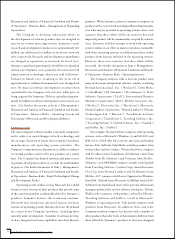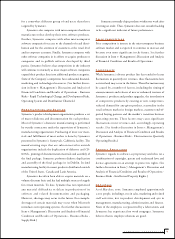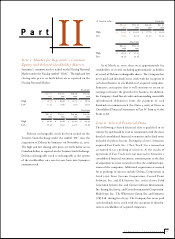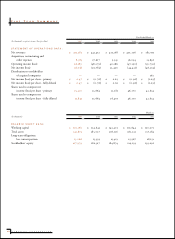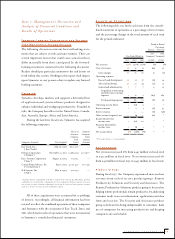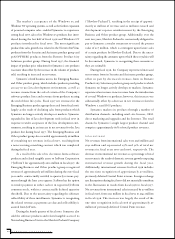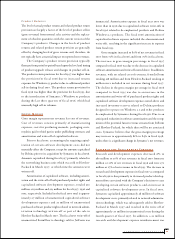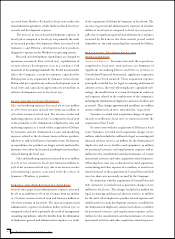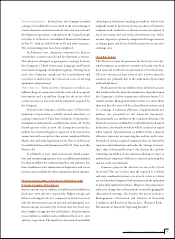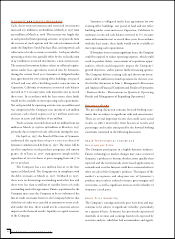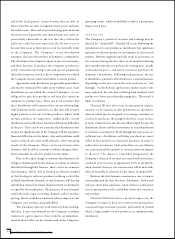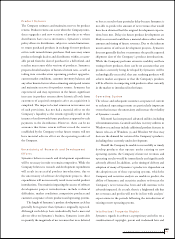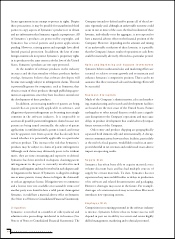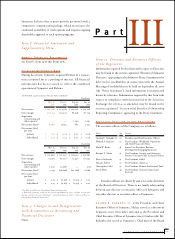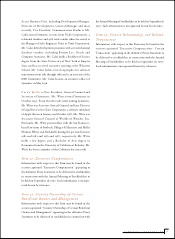Symantec 1997 Annual Report Download - page 26
Download and view the complete annual report
Please find page 26 of the 1997 Symantec annual report below. You can navigate through the pages in the report by either clicking on the pages listed below, or by using the keyword search tool below to find specific information within the annual report.
Liquidity and Capital Resources
Cash, short-term investments and restricted investments
increased $79 million to $208 million at March 31, 1997 from
$129 million at March 31, 1996. This increase was largely due
to cash provided from operating activities, net proceeds from
the exercise of stock options and the sales of common stock
under the Employee Stock Purchase Plan, and improved cash
collections of trade accounts receivable. Cash provided by
operating activities was partially offset by the reclassification
of $47 million to restricted investments, a non-current asset.
The restricted investment balance relates to collateral require-
ments under lease agreements entered into by Symantec
during the current fiscal year. Symantec is obligated under
lease agreements for two existing office buildings, one parcel
of land and one office building under construction in
Cupertino, California to maintain a restricted cash balance
invested in U.S. treasury notes with maturities not to exceed
three years. In accordance with the lease terms, these funds
would not be available to meet operating cash requirements.
Net cash provided by operating activities was $94 million and
was comprised of the Company’s net income of $26 million
and non-cash related expenses of $37 million and a net
decrease in assets and liabilities of $31 million.
Trade accounts receivable decreased $11 million from $59
million at March 31, 1996 to $48 million at March 31, 1997
primarily due to improved cash collections during the year.
On April 29, 1997, the Board of Directors of Symantec
authorized the repurchase of up to 1,000,000 shares of
Symantec common stock by June 13, 1997. The shares will be
used for employee stock purchase programs and option
grants. As of June 13, 1997, management completed the
repurchase of 500,000 shares at prices ranging from $16.57 to
$17.00 per share.
The Company has a $10 million line of credit that
expires in March 1998. The Company was in compliance with
the debt covenants at March 31, 1997. At March 31, 1997,
there were no borrowings outstanding under this line and
there were less than $1 million of standby letters of credit
outstanding under this agreement. Future acquisitions by the
Company may cause the Company to be in violation of the
line of credit covenants; however, the Company believes that
if the line of credit were canceled or amounts were not avail-
able under the line, there would not be a material adverse
impact on the financial results, liquidity or capital resources
of the Company.
Symantec is obligated under lease agreements for two
existing office buildings, one parcel of land and one office
building under construction in Cupertino, California to
maintain a restricted cash balance invested in U.S. treasury
notes with maturities not to exceed three years. In accordance
with the lease terms, these funds would not be available to
meet operating cash requirements.
If Symantec were to sustain significant losses, the Company
could be required to reduce operating expenses, which could
result in product delays, reassessment of acquisition oppor-
tunities, which could negatively impact the Company’s
growth objectives, and/or pursue further financing options.
The Company believes existing cash and short-term invest-
ments will be sufficient to fund operations for the next year.
(See further discussion in Item 7: Management’s Discussion
and Analysis of Financial Condition and Results of Operations
- Business Risks - Fluctuations in Quarterly Operating
Results and Management of Expanding Operations.)
Business Risks
The preceding discussion contains forward-looking state-
ments that are subject to significant risks and uncertainties.
There are several important factors that could cause actual
results to differ materially from historical results and
percentages and results anticipated by the forward-looking
statements contained in the following discussion.
Rapid Technological Change and
Development Risks
The Company participates in a highly dynamic industry.
Future technology or market changes may cause certain of
Symantec’s products to become obsolete more quickly than
expected and the trend towards server-based applications in
networks and over the Internet could have a material adverse
effect on sales of the Company’s products. The impact of the
market’s acceptance and adoption rate of Symantec’s
products may result in reduced revenues, gross margins and
net income, as well as significant increases in the volatility of
Symantec’s stock price.
Stock Price Volatility
The Company’s earnings and stock price have been and may
continue to be subject to significant volatility, particularly
on a quarterly basis. Symantec has previously experienced
shortfalls in revenue and earnings from levels expected by
securities analysts, which has had an immediate and signifi-
24 SYMANTEC CORPORATION


